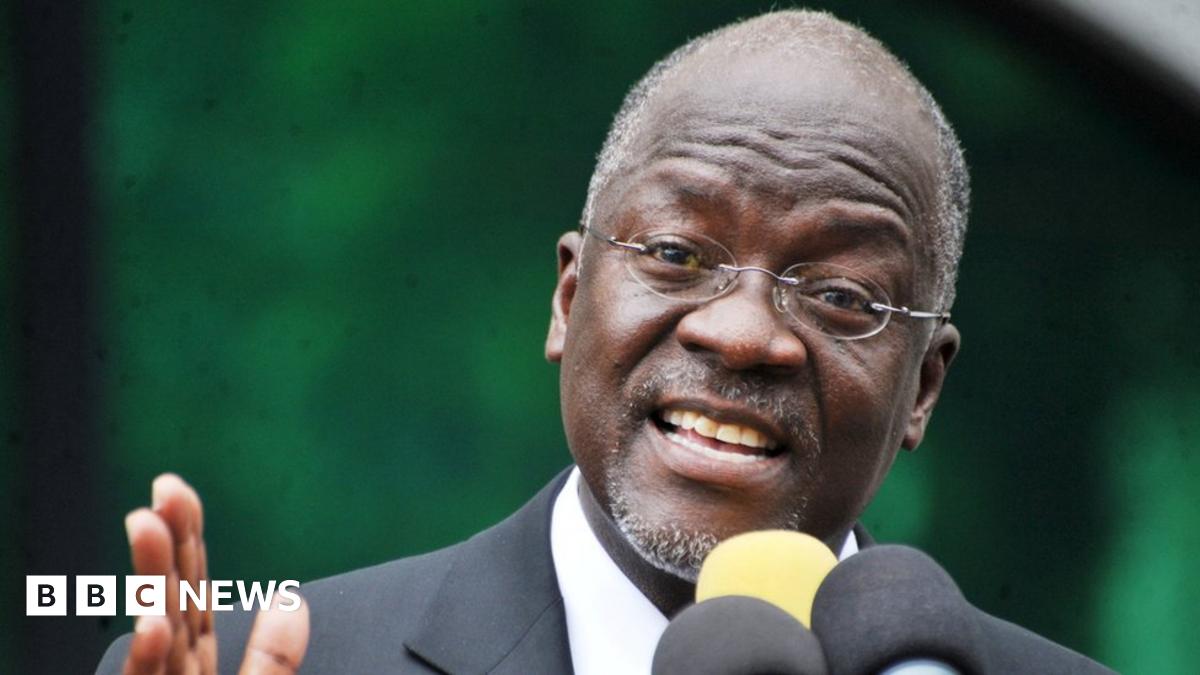SOTTREADER
The Living Force

John Magufuli: Tanzania's president dies aged 61 after Covid rumours
Covid-sceptic John Magufuli had not been seen in public for more than two weeks.
Annnnnd he's dead....

President John Magufuli’s disappearance makes him potentially the 2nd “Covid denier” head of state to lose power.
Last summer Pierre Nkurunziza, the President of Burundi, refused to play along with Covid and instructed the WHO delegation to leave his country…before dying suddenly of a “heart attack” or “suspected Covid19”. His successor immediately reversed every single one of his Covid policies, including inviting the WHO back to the country.

Source africanews.com President Magufuli
He's probably not aware that he might have a heart attack pretty soon...[Feb 8, 2021]

"President John Magufuli died of a heart ailment that he has battled for over 10 years," Samia Suluhu Hassan (now the acting president of Tanzania) said. She added that the president had been receiving treatment at Mzena hospital since Sunday."
In June 2020, he claimed his country had eradicated coronavirus "by the grace of God," questioned the safety of foreign Covid-19 vaccines and made no plan to procure any shots for his country, instead pushing for the use of herbal medicine and steam treatments.
FWIW, Ursus, I had the same thoughts, considering what they did to the President of Burundi. It's very sad news, though and his successor will most likely reverse Tanzania's Covid policies as well?I feel sorry for the cynical remark I made six weeks ago...

Scientists don’t know whether the vaccine causes the syndrome, and if so, what the mechanism is. “Everyone’s scratching their heads: Is this a real signal?” says Robert Brodsky, a hematologist at Johns Hopkins University. But vaccine safety officials say they did not take the decision lightly, and that symptoms seen in at least 13 patients, all between ages 20 and 50 and previously healthy, in at least five countries are more frequent than would be expected by chance. The patients, at least seven of whom have died, suffer from widespread blood clots, low platelet counts, and internal bleeding—not typical strokes or blood clots. “It’s a very special picture” of symptoms, says Steinar Madsen, medical director of the Norwegian Medicines Agency. “Our leading hematologist said he had never seen anything quite like it.”
In Europe, a 49-year-old intensive care nurse in Austria was one of the first cases. She died last week from what officials called “clotting disorders” that culminated in internal bleeding. (A colleague at the same hospital who received the vaccine developed lung embolisms, but was expected to recover.) A similar constellation of symptoms has been identified in four patients in Norway, two of whom have died, Madsen says.
German officials said Monday they had received seven reports of cerebral venous thrombosis (CVT), three of them fatal, in patients who had recently been vaccinated with the AstraZeneca vaccine. In this rare type of stroke, the vein that drains blood from the brain is blocked, which can result in massive, deadly bleeding in the brain. All of the patients also had low levels of platelets, which aid in clotting, a possible sign of more widespread clotting. One affected patient had blood clots “from head to toe,” says Clemens Wendtner, a hematology and infectious disease specialist at the Munich Clinic, Schwabing. The symptoms remind Wendtner of a syndrome called disseminated intravascular coagulation (DIC), in which blood clots form throughout the body, depleting its platelet supply. When the clots cause blood vessels to burst, the body is less able stop the internal bleeding, which can damage the brain or other organs.
Arnold Ganser, a hematologist at Hannover Medical School, says he is treating another patient who developed CVT within days of vaccination. He says that patient appears to be suffering from another condition called atypical hemolytic uremic syndrome (HUS). (The patient, a woman older than 60, is not yet counted in the seven cases announced in Germany on Monday.) Although it can look similar to DIC, HUS develops from damage to the vascular walls. It is usually caused by a bacterial toxin, but can also arise from unknown factors. The condition can be treated with an antibody targeting the complement system, a cascade of molecular interactions that aids immune clearance of pathogens or diseased cells, and Ganser says the patient appeared to be responding to that treatment.
Germany paused vaccinations on Monday on the recommendation of the Paul Ehrlich Institute (PEI), the country’s agency in charge of vaccine safety. PEI head Klaus Cichutek says all seven cases of CVT had occurred between 4 and 16 days after vaccination, and that an analysis suggested only a single case would normally be expected among the 1.6 million people who received the vaccine in that time window. A group of experts convened on Monday “agreed unanimously that there seemed to be a pattern here and that a link to the vaccine was not implausible and that this should be investigated,” Cichutek says.
Other factors played a role in the recommendation, including the fact that the syndrome is so severe and difficult to treat, and that it affects relatively young people who are at low risk of dying from COVID-19. It was also an opportunity to urge people to seek medical attention immediately if they develop persistent headaches or unusual bruising in the week following vaccination, Cichutek says.
Madsen believes the unusual symptoms may be the result of “a very strong immunological reaction.” Acute infections can trigger clotting and bleeding, sometimes culminating in DIC, Wendtner notes. But abnormal clotting is also a feature of COVID-19. It’s possible, Wendtner says, that the unusual cases had a COVID-19 infection before they got vaccinated; many were health care workers and teachers who may have been exposed at work. Coming on top of the infection, the vaccine might somehow have triggered an overreaction by the immune system, sparking the clotting syndrome. Ganser thinks patients suffering from CVT may be the tip of the iceberg and that more people may suffer similar, but milder, symptoms.
AstraZeneca, he claimed, is sold to member states at the price of €1,5-2 per dose, whilst its US rivals Johnson & Johnson, Moderna and Pf2izer are sold respectively at €6-7, €14-15 and €15-16 per dose.
Russia's Sputnik V vaccine, not yet approved by the bloc but used in Hungary, is sold at about €8 per dose.
Highly suspicious. Anti-lockdown President Magufuli of Tanzania is the SECOND east African leader to 'die suddenly from a heart attack/Covid-19' in less than a year. Burundi had ONE official Covid-19 death at the time, and Tanzania today has 21 (pop. 61m). What are the odds?
John Magufuli: Tanzania's president dies aged 61 after Covid rumours
Covid-sceptic John Magufuli had not been seen in public for more than two weeks.www.bbc.co.uk
Annnnnd he's dead....

It was not necessary cynical, you just see what the danger for his life because we know at this point how things are going. We know also what they did to Kadafi. Africa is an ali baba cave for them, millions of people that they want to vaccinate, millions of dollars.I feel sorry for the cynical remark I made six weeks ago...

 www.tiktok.com
www.tiktok.com
What are the odds?

 bpoc2020.nl
bpoc2020.nl

Chief physician and professor Pål Andre Holme told Norwegian papers on Thursday, just hours before the EMA was set to release the findings of its promised "safety review" (which was conducted even more hastily than the initial vaccine studies), that he has a new theory about what caused the reactions in the health workers, and unfortunately, per Holme, the AstraZeneca jab acted as the trigger.
Though he acknowledged the theory was just that - a theory, Holme insisted there was nothing else that could have triggered such an intense immune response in all three patients. The vaccine was the only common factor."The reason for the condition of our patients has been found," chief physician and professor Pål Andre Holme announced to Norwegian national newspaper VG today.
{...]
"Our theory that this is a powerful immune response which most likely was caused by the vaccine has been found. In collaboration with experts in the field from the University Hospital of North Norway HF, we have found specific antibodies against blood platelets that can cause these reactions, and which we know from other fields of medicine, but then with medical drugs as the cause of the reaction," the chief physician explains to VG.
When asked to clarify why he says “most likely” in the quote, Holme confidently responds that the reason for these rare cases of blood clots has been found.
"We have the reason. Nothing but the vaccine can explain why these individuals had this immune response," he states.
VG also asks how Holme can know that the immune response is not caused by something other than the vaccine.
"There is nothing in the patient history of these individuals that can give such a powerful immune response. I am confident that the antibodies that we have found are the cause, and I see no other explanation than it being the vaccine which triggers it," he responds.
Canada's COVID Alert app is “completely useless” right now: health expert
Less than four per cent of Canadians who tested positive for COVID-19 used the COVID Alert app to warn other people that they might have been exposed to the virus, according to recent data from Health Canada. An infectious disease expert told Global News with so few people using the voluntary app as it was intended, it’s “essentially completely useless” right now. The app debuted in Ontario in July 2020 and has since been adopted across Canada except in Alberta, British Columbia, Yukon and Nunavut.
Highly suspicious. Anti-lockdown President Magufuli of Tanzania is the SECOND east African leader to 'die suddenly from a heart attack/Covid-19' in less than a year. Burundi had ONE official Covid-19 death at the time, and Tanzania today has 21 (pop. 61m). What are the odds?

Coronavirus and regime Change: Burundi's covid coup
While the people of the western world occupy themselves wearing masks, pointing fingers and using so much hand sanitizer it literally kills them, the big world of Geo-Politics still ticks along, following the same tired old patterns with only...www.sott.net
